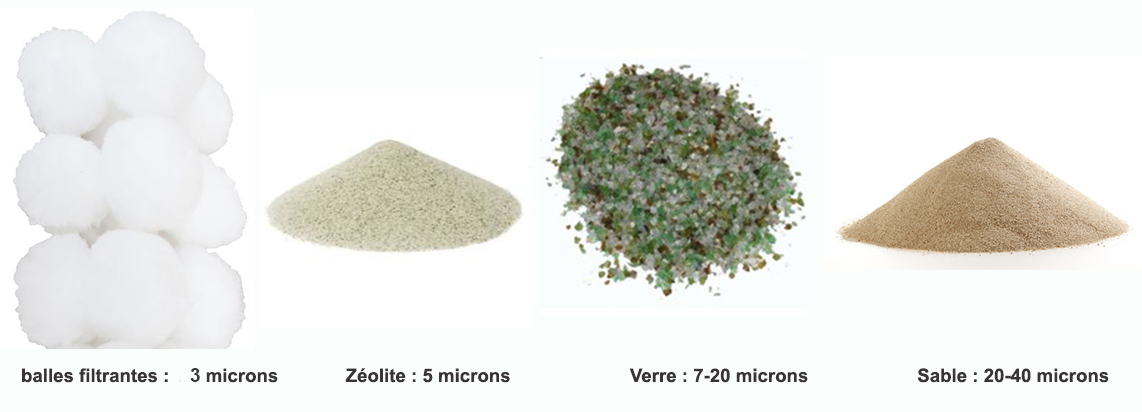Choose the right filter media for my pool
What is the function of the filter media?
First of all it filters and then it absorbs the impurities in the pool. The filter media is the essential ally for having a clean pool whatever the model (above ground, spa or underground). It is generally arranged in the filter near the pump.
This impure water is first sucked through the filter. Then the filter media, placed in the filter, will have the function of sucking up all the dirt to make it healthy and clear. If the dirt is retained by the filter, the water will be redirected back to the pond clean.
The filter media therefore requires cleaning or even regular replacement in order for it to do its job properly and to remove the impurities left by the water. Without cleaning or replacement, it could become less efficient.
Discover the various types of filter media
The cartridge
Small pools with less than 100m3 capacity are accustomed to using the cartridge as filter media, including tubular, freestanding and above-ground models and spas.
Benefits
- The cheapest
- Good quality filtration
- Simple to use and easy to change
- Does not consume too much water
Disadvantages
- Requires regular maintenance
- Requires systematic change
- Its use becomes expensive over the years.
- Poor quality on some cartridges
- Not compatible with water with high limestone content
- Risk of clogging with certain unsuitable treatment products (flocculant)
The Diatom
Diatomaceous earth is one of the most widely used filter media. It eliminates impurities thanks to its very fine white powder made of fossilized algae. It is ideal to stick it on the filter membrane.
Benefits
- Offers quality filtration finess
- Lower consumption of treatment products
- Saving water
Disadvantages
- Expensive to clean and buy
- Maintenance complexity
- Regular need to be recharged
- Not compatible with water with a high limestone content.
- Limited use, especially with certain treatment products (flocculants) that can clog the inner filter.
- Should not be used for pools placed in a too windy environment.
The Sand and Glass
These two filter media share the same methods of use except that glass is more reliable than sand with its smooth appearance that does not stain quickly. Glass is also appreciated for its excellent filtration fineness and long service life.
Benefits
- Durability, comfort, ease of use
- Simple and easy maintenance
- Good quality/price
Disadvantages
- Need flocculants to offer good quality filtration
- Consumes a lot of water
- Bulky filter
- Filter more expensive than cartridges
The new ultimate filter media: filter balls
Don't hesitate to switch to filter balls to avoid having sand in the pool and then to avoid carrying 25kg sandbags every time you want to replace your filter media. The filter balls constitute an efficient, innovative filter media with multiple advantages. When used with the same filter, the filter balls break the codes to take the place of glass and sand. They will change the way you filter the pond.
The most:
- Easy to use and very light weight
- The filter balls are assembled in a 700g carton, so they are easy to transport.
- This box of 700g of bales can replace a 25kg sandbag.
- They are as easy to use as glass and filter sand
- Excellent filtration quality
- If the sand offers a filtration fineness of 40 microns, the filter balls offer a finesse filtration of 1.5 micron thanks to their fibrous aspect.
- Very high impurity continence: 98%

- Large Economy
- Up to 40% energy savings
- Saves water as the filter balls reduce backwashing sessions
- Ecological:
- 100% polyethylene and 100% recyclable.
- Absence of toxic elements
- Long life (5 years)
- Great resistance:
- The filter balls are suitably resistant to chemical elements thanks to their 100% polyester composition.
- They are also resistant to climatic variations such as winter cold and summer heat.
- They always keep the same appearance and do not risk clogging, unlike sand, which changes its appearance over time.
Ratios between sand filter and filter balls
- 1 carton of 700g is equivalent to a sand filter of 4m³/h
- 2 boxes of 700g are equivalent to a 6m³/h sand filter.
- 3 cartons of 700g are equivalent to a sand filter of 8-10m³/hour
- 4 boxes of 700g are equivalent to a 12m³/h sand filter.
- 6 boxes of 700g are equivalent to a 14m³/h sand filter.
- 10 boxes of 700g are equivalent to a 22m³/h sand filter.
- 14 boxes of 700g are equivalent to a sand filter of 33m³/hour.
Installation steps:
Filter balls are used in the same way as sand and glass but without any defect.
- Step 1: The filter tank of the sand filter must be open.
- Step 2: Remove the previously used filter and remove impurities in the filter container.
- Step 3: Use 700g of filter balls (25kg of sand) and put them in the tank.
- Step 4: Close the tank
- Step 5: Activate filtering.
